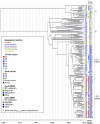Evolutionary History of the Global Emergence of the Escherichia coli Epidemic Clone ST131
- PMID: 27006459
- PMCID: PMC4807372
- DOI: 10.1128/mBio.02162-15
Evolutionary History of the Global Emergence of the Escherichia coli Epidemic Clone ST131
Abstract
Escherichia colisequence type 131 (ST131) has emerged globally as the most predominant extraintestinal pathogenic lineage within this clinically important species, and its association with fluoroquinolone and extended-spectrum cephalosporin resistance impacts significantly on treatment. The evolutionary histories of this lineage, and of important antimicrobial resistance elements within it, remain unclearly defined. This study of the largest worldwide collection (n= 215) of sequenced ST131E. coliisolates to date demonstrates that the clonal expansion of two previously recognized antimicrobial-resistant clades, C1/H30R and C2/H30Rx, started around 25 years ago, consistent with the widespread introduction of fluoroquinolones and extended-spectrum cephalosporins in clinical medicine. These two clades appear to have emerged in the United States, with the expansion of the C2/H30Rx clade driven by the acquisition of ablaCTX-M-15-containing IncFII-like plasmid that has subsequently undergone extensive rearrangement. Several other evolutionary processes influencing the trajectory of this drug-resistant lineage are described, including sporadic acquisitions of CTX-M resistance plasmids and chromosomal integration ofblaCTX-Mwithin subclusters followed by vertical evolution. These processes are also occurring for another family of CTX-M gene variants more recently observed among ST131, theblaCTX-M-14/14-likegroup. The complexity of the evolutionary history of ST131 has important implications for antimicrobial resistance surveillance, epidemiological analysis, and control of emerging clinical lineages ofE. coli These data also highlight the global imperative to reduce specific antibiotic selection pressures and demonstrate the important and varied roles played by plasmids and other mobile genetic elements in the perpetuation of antimicrobial resistance within lineages.
Importance: Escherichia coli, perennially a major bacterial pathogen, is becoming increasingly difficult to manage due to emerging resistance to all preferred antimicrobials. Resistance is concentrated within specificE. colilineages, such as sequence type 131 (ST131). Clarification of the genetic basis for clonally associated resistance is key to devising intervention strategies. We used high-resolution genomic analysis of a large global collection of ST131 isolates to define the evolutionary history of extended-spectrum beta-lactamase production in ST131. We documented diverse contributory genetic processes, including stable chromosomal integrations of resistance genes, persistence and evolution of mobile resistance elements within sublineages, and sporadic acquisition of different resistance elements. Both global distribution and regional segregation were evident. The diversity of resistance element acquisition and propagation within ST131 indicates a need for control and surveillance strategies that target both bacterial strains and mobile genetic elements.
Copyright © 2016 Stoesser et al.
Figures







References
-
- Johnson JR, Clermont O, Johnston B, Clabots C, Tchesnokova V, Sokurenko E, Junka AF, Maczynska B, Denamur E. 2014. Rapid and specific detection, molecular epidemiology, and experimental virulence of the O16 subgroup within Escherichia coli sequence type 131. J Clin Microbiol 52:1358–1365. doi:10.1128/JCM.03502-13. - DOI - PMC - PubMed
Publication types
MeSH terms
Grants and funding
LinkOut - more resources
Full Text Sources
Other Literature Sources
Medical
Molecular Biology Databases
Miscellaneous
